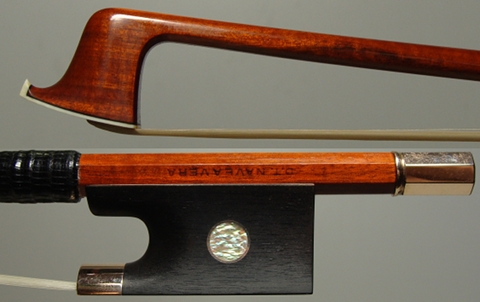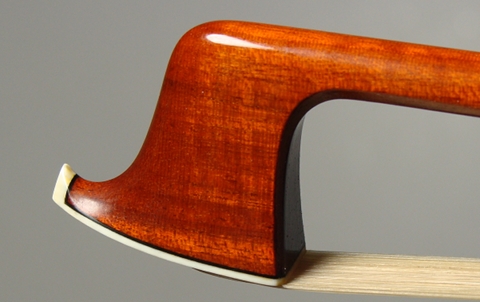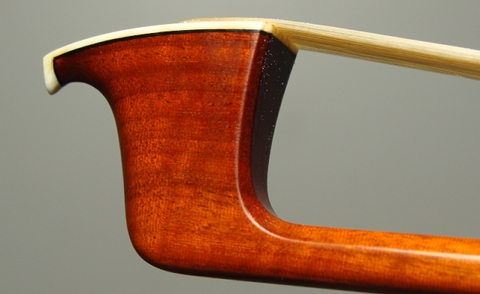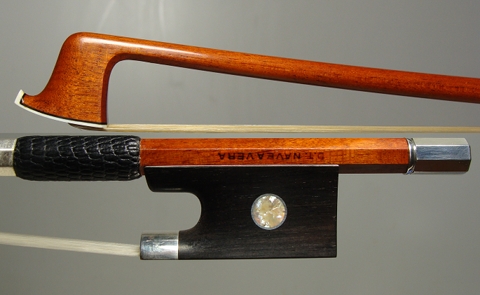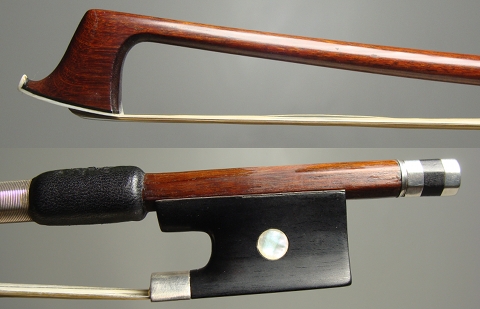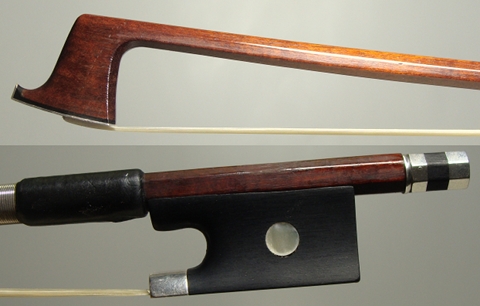THE MYSTERIES OF THE VIOLAI have been thinking of what would be the quickest and most fulfilling way to give an answer to my Californian reader, without being misunderstood, and as I find the questions of general interest I have decided to dedicate Mr. Marin an entire post.
Viola bow D.T. Navea Vera in gold, tortoise and mother of pearl “heart” - “The Giuranna” First question: The question is very well articulated and also correct, except the fact that in this case we are only talking about viols and not instruments on a general level, and therefore it provides an ironic answer; the bows of this instrument are just a little bigger and about 10 g heavier. If we expand the question to include all the instruments of the quartet, the answer will be more complex. In fact, if we talk about the mechanics of all the bows of a quartet they are more or less the same, because they arrive from the same physical concept. The type of curves used by the French bow school are two: the first one was the curve on the “Cramer” model, which was used until the second half of the 18th century, this curve is commonly named the “Peccatte curve”, the second one was developed by F.N. Voirin and resisted, with some modifications, until the 70ties, named the “Sartory curve”. Both models can be used either for violin, for viola and for violoncello bows, changing weight and measurements.
The choice of one of these two models determinates the mechanical and sound differences of the bows within the quartet; but what really causes differences of the bows, and not only, is the quality of the material. Every instrument, violin, viola, or violoncello have a different physical composition, as the model and material used, the age of the instrument cc. The skill of the bow maker is to understand the instrument and decide the right wood for the bow. If the instrument is made of light wood and tend to have a bright sound it could be matched with a bow made of a dense wood to bring more focus onto the sound. Whereas if the instrument is made with major thicknesses, and of a more heavy wood, it will have a more closed tone, and you could match the instrument with a bow made of a wood of a media density, giving more air to the sound. Then you need to take into account the projection capability of the instrument. Some weeks ago I happened to listen to a magnificent violoncello Strad. Even though I know that the owners bows are not of a high performance, that instrument filled up the hall by it self. Of course, a piece of such caliber doesn't need much support and therefor you could match it with a stick where the speed of the sound isn't particularly elevated. On the contrary if the instrument has problems releasing the sound or rigidity, you could match it with a stick made of a more nervous wood and in this way balance out and reduce the deficiencies.
Whereas I am concerned, the viola bow does not differ in any way from the rest of the bows in the quartet; every instrument is unique and has to be observed singularly. To finish up my reflections and the answer of the first of the two questions I will add a provocation, which then leeds to the second question. The tricky part is not the instrument “viola”, but understanding the “viola player”.
Viola bow D.T. Navea Vera made in silver, mother of pearl - “cuore” The viola can appear as something between a violin and a cello, whereas it actually has its own defined character. Very often though, it is the violist to have a hybrid taste, they play the viola but want to hear the tone of a violoncello. Of my opinion violists prefer a darker tone, which isn't the natural sound of the viola. You can obtain this particular sound by using very dark and dense wood; the problem is that this material often isn't enough tense. The tannin, which gives the coloration, mechanically acts like a gum inside the wood and often inhibits the mechanic quality and therefore the sound; although it has the ability to brighten up anyone. Usually this type of wood doesn't carry out the sound in the hall and doesn't give definition, it satisfies the violist because he hears a warm and reassuring tone. A dull tone of which the craftsman has had to struggle less to make. This type of wood made fury arise especially in the second half of the 18th and the beginning of the 19th century. A wood which is very ductile and easy to work even without experience and talent. More importantly this material allowed to fasten up production of bows, which leeds us to the second question.
Viola bow by Dominique Peccatte Second question: Leaving a part that I have already written an article about JTL and the Lotte, the parameter that stabilizes the value rating to the bows are several. The period in which they were made, innovations introduced, workshops and craftsmen attended, and not least the type of production. Hundreds of honest workers worked at the workshops factories in Mirecourt and they produced an amazing quantity of bows and instruments; we are talking about 5/6000 bows a year. Note, on his price list C.N.Bazin had the price of bows sold in bunches; he sold them like eggs. As for the bows made by JTL and Lotte, in these bows there are no mechanic, style or sound research and they do not have long to go. Whereas a Chinese is perfectly capable to make bows comparable to the JTL, it would be very difficult for him to be able to make one as the one you see on the photo; which by the way isn't made in dark wood.
Viola bow by Francois Xavier Tourte (the frog in copy) To Andres To read more about this topic: CRAMER VERSUS CRAMER; OR RIGHTLY THE EVOLUTIONARY PROCES PART I CRAMER VERSUS CRAMER; OR RIGHTLY THE EVOLUTIONARY PROCES PART II VIOLIN BOW BY FRANCOIS NICOLAS VOIRIN 1870 – 75 LOUIS EMILE JEROME THIBOUVILLE-LAMY; THE MANAGING DIRECTOR FRANCOIS AND ROGER LOTTE; ANOTHER SMALL FAMILY CHARLES NICOLAS BAZIN; THE FOUNDER So long, Paolo
|
   |






